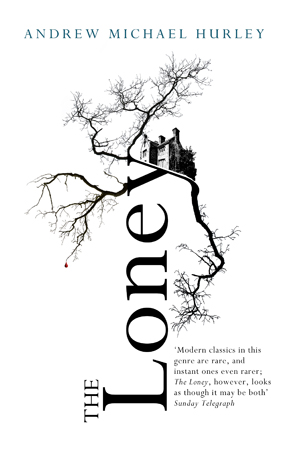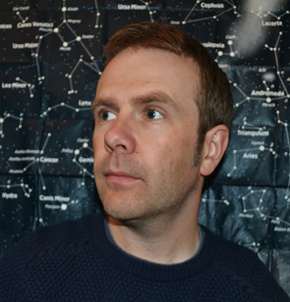Nature, faith and horror
by Andrew Michael Hurley
“An amazing piece of fiction.” Stephen King
I’ve always been drawn to wild, lonely places. It might have something to do with the summer holidays I had as a child – never a hotel in Benidorm or Tenerife, but camping in Keswick or Wharfedale. We weren’t a family that lobstered on sun loungers; our days were spent circumnavigating a lake or scrambling to the top of a mountain we’d picked out of the Wainwright book. Not that I complained. Standing, say, at the summit of Scafell or Skiddaw or Blencathra (those names!) I didn’t want to be anywhere else. There was a feeling of achievement, yes, but there was always something else there too – a curious, complex mixture of belonging, insignificance, a peacefulness in the solitude, the thrill of high ridges and loose rocks. Something spiritual. Maybe.
I suppose that most writers must write about what moves them and I think I’ve always had more of a sense of fulfilment when I’ve managed to find the right words to describe or explore something in nature. Writing about the natural world and our relationship with it demands an attention to detail and therefore a different kind of language. From Gilbert White to the Romantics, to Edward Thomas, Robert Frost and contemporary ‘nature’ writers such as Robert Macfarlane, Roger Deakin, Richard Mabey, it was these kinds of writers that I found particularly inspiring when I began to spend time on the north Lancashire coast about five or six years ago and first considered the idea of setting a novel there.
It’s a strange place. Stuck in time. Out of time. There is a kind of bleak beauty in the mudflats and the winding channels, the way the light plays in the emptiness, but there is a presence there too. The Morecambe Bay area is notorious for its dangerous tides and sinking sands – “It’s the biggest graveyard in the north of England”, says one character in the novel – and I felt that sense of menace very strongly. It seemed a place where nature was in its raw state. As the narrator says: “Things lived at the Loney as they ought to live… Nature got on with itself. Its processes of death and replenishment happened without anyone noticing…”
It is because nature is so detached, so unpredictable and alien in its motivations that it can be so intimidating. It’s something that’s there quite directly in, say, a story like The Birds and it also provides the creeping sense of threat in lots of gothic stories – think of the windy moors in Wuthering Heights, the gathering snowstorm in Dracula’s Guest or the sea frets in The Woman in Black. But in The Loney, I wanted to use nature to say something about faith.
The novel recounts the Easter of 1976, when a group of Catholic pilgrims journey from London to Lancashire to embark on a retreat and hope to cure the narrator’s mute and mentally disabled brother, Hanny. The parishioners are led by their new priest, Father Bernard, a young, liberal replacement for the late Father Wilfred, whose hardline orthodoxy haunts the whole trip. It is through him that the pilgrims have learnt that the landscape of the Loney is not only an expression of God’s power, but also a place of communion between man and God, a place where one is revealed to the other. The sea and the weather are viewed through the language of the Bible and therefore become explicable, part of divine, loving purpose, part of a personal journey.
The Loney has been compared to The Wicker Man, and although the film only flickered in the background of my thoughts as I was writing, there is an interesting parallel in terms of how the ‘horror’ works.”
But in one of the key chapters of the novel, unbeknownst to his parishioners, Father Wilfred suddenly understands that the Loney is utterly indifferent to him, to his flock, to human life in general. It becomes drained of its poetic, religious meaning and he sees it for the wild, feral place it is. The Loney is a Godless void. It is the world as it really is, beyond the reach of God or language or understanding.
The Loney has been compared to The Wicker Man, and although the film only flickered in the background of my thoughts as I was writing, there is an interesting parallel in terms of how the ‘horror’ works. Anthony Shaffer, the screenwriter for the film, said that it comes from the fact that no one other than the character of Sergeant Howie thinks that what the islanders are doing is wrong. For them, the blood sacrifice is normal and absolutely necessary. It’s that warping of what we commonly understand to be reasonable, logical and moral that makes it so disturbing. And it’s there in The Loney too, amongst the pilgrims – particularly in the character of Mummer (the narrator’s mother) – who cannot see that there is anything wrong in the way that they treat Hanny. Religious certainty encourages and permits a cruelty that is dressed up as love and devotion.
Not all of this was planned right from the start, of course, and that was part of the excitement of writing the novel. It was as the story emerged and the characters came into their own that I began to see the ways in which feelings about nature, a discussion of faith and the creation of ‘horror’ could merge. Though whether it says anything definitive about those things, I’m not sure. For me the novel was a process of exploration and still is. Even now that The Loney has been published I still find myself thinking about some of the questions that I asked myself as I was writing it. Like the place that first inspired it, I think the story will continue to haunt me for some time to come.
 Andrew Michael Hurley has lived in Manchester and London, and is now based in Lancashire, where he teaches English Literature and Creative Writing. He has had two collections of short stories published by Lime Tree Press. The Loney, his first novel, was first published in October 2014 by Tartarus Press as a 300-copy limited edition and is now published by John Murray in hardback and eBook. More info.
Andrew Michael Hurley has lived in Manchester and London, and is now based in Lancashire, where he teaches English Literature and Creative Writing. He has had two collections of short stories published by Lime Tree Press. The Loney, his first novel, was first published in October 2014 by Tartarus Press as a 300-copy limited edition and is now published by John Murray in hardback and eBook. More info.
Author portrait © Joanna Hurley

